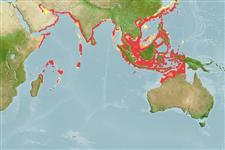Environment: milieu / climate zone / depth range / distribution range
Ecologia
marinhas demersal; intervalo de profundidade 30 - 105 m (Ref. 89707). Tropical; 36°N - 17°S, 48°E - 153°E
Indo-West Pacific: Persian Gulf to Taiwan, Indonesia and the northern coast of Australia. Not known from Japan, but may occur here. It has not been found at any islands of Micronesia nor Polynesia.
Length at first maturity / Tamanho / Peso / Idade
Maturity: Lm 36.0, range 42 - ? cm
Max length : 76.0 cm TL macho/indeterminado; (Ref. 2852)
Espinhos dorsais (total): 11; Raios dorsais moles (total): 16-18; Espinhos anais 3; Raios anais moles: 8 - 9. Recognized by the bluish lower half of the caudal fin and the lack of spots there compared to the upper half (Ref. 48635); characterized further by: generally brown color; head, body and fins with red to dark brown spots; body scales ctenoid, except cycloid scales on nape, thorax and ventrally on abdomen; body with auxiliary scales; elongate body, greatest depth 3.0-3.5 in SL; truncate to slightly rounded caudal fin; short pelvic fins, 1.9-2.4 in head length (Ref. 90102); head length 2.4-2.7 times in standard length; interorbital area flat to slightly convex; preopercle angle with 2-9 enlarged serrae, adults with a notch above angle; straight upper edge of operculum; scaly maxilla, reaching to or beyond vertical at rear edge of eye; 2 rows of subequal teeth on midlateral part of lower jaw (Ref. 089707).
Occur on shallow banks, but is not known from well-developed coral reefs (Ref. 27253) and adjacent soft substrate in depths of 30-105 m (Ref. 089707). Also found in silty coastal reefs and estuaries. Solitary (Ref 90102). Benthic (Ref. 75154). In Hong Kong live fish markets (Ref. 27253). Usually taken by trawling in 30-45 m or by hand-lining over rocky banks; not found from coral reefs (Ref. 11441).
Heemstra, P.C. and J.E. Randall, 1993. FAO Species Catalogue. Vol. 16. Groupers of the world (family Serranidae, subfamily Epinephelinae). An annotated and illustrated catalogue of the grouper, rockcod, hind, coral grouper and lyretail species known to date. Rome: FAO. FAO Fish. Synop. 125(16):382 p. (Ref. 5222)
Categoria na Lista Vermelha da IUCN (Ref. 130435)
Ameaça para o homem
Harmless
Utilização humana
Pescarias: pouco comercial; Aquacultura: espécies comerciais
Mais informação
ReferênciasAquaculturaPerfil para aquaculturaEstirpesGenéticaElectrophoresesHereditariedadeDoençasProcessamentoNutrientsMass conversion
ColaboradoresFotografiasStamps, Coins Misc.SonsCiguateraVelocidadeTipo de nataçãoÁrea branquialOutras referênciasCérebrosVisão
Ferramentas
Relatórios especiais
Descarregue XML
Fontes da internet
Estimates based on models
Preferred temperature (Ref.
123201): 23.2 - 28.4, mean 27.4 °C (based on 472 cells).
Phylogenetic diversity index (Ref.
82804): PD
50 = 0.5000 [Uniqueness, from 0.5 = low to 2.0 = high].
Bayesian length-weight: a=0.01259 (0.00798 - 0.01986), b=3.06 (2.93 - 3.19), in cm total length, based on LWR estimates for this species & Genus-body shape (Ref.
93245).
Nível Trófico (Ref.
69278): 3.9 ±0.5 se; based on size and trophs of closest relatives
Generation time: 8.8 ( na - na) years. Estimated as median ln(3)/K based on 1
growth studies.
Resiliência (Ref.
120179): Baixo, tempo mínimo de duplicação da população 4,5 - 14 anos (tmax=24).
Fishing Vulnerability (Ref.
59153): High vulnerability (60 of 100).
Nutrients (Ref.
124155): Calcium = 63.8 [27.4, 146.6] mg/100g; Iron = 0.814 [0.386, 1.864] mg/100g; Protein = 17.7 [16.0, 19.2] %; Omega3 = 0.191 [0.099, 0.351] g/100g; Selenium = 65.2 [30.8, 150.7] μg/100g; VitaminA = 44.3 [10.7, 180.9] μg/100g; Zinc = 1.21 [0.77, 1.97] mg/100g (wet weight);
